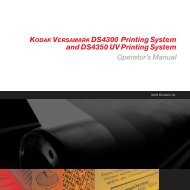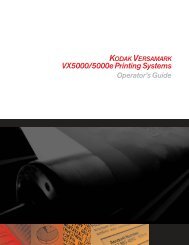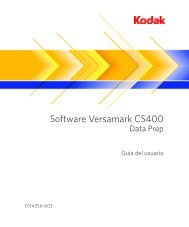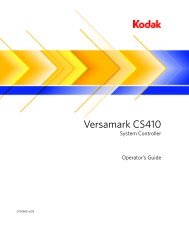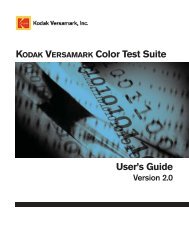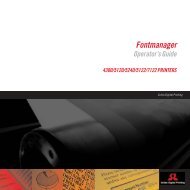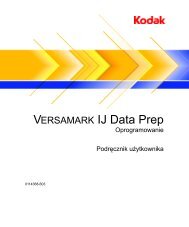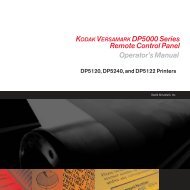Print Station Operator's Guide - Kodak
Print Station Operator's Guide - Kodak
Print Station Operator's Guide - Kodak
You also want an ePaper? Increase the reach of your titles
YUMPU automatically turns print PDFs into web optimized ePapers that Google loves.
Chapter 1. Overview<br />
<strong>Print</strong> <strong>Station</strong> Functions<br />
The typical printing system requires a system controller, which may<br />
accept input data in various formats from a variety of inputs, including but<br />
not limited to a Local Area Network (LAN) connection and/or computer<br />
disks. A typical format is Ink-Jet <strong>Print</strong>er Data Stream (IJPDS). The<br />
controller uses controls in the IJPDS data according to job setup<br />
instructions and operator commands. The controller sends the data and<br />
controls to a data station.<br />
Figure 1.2<br />
Typical ink-jet printing system<br />
Controller<br />
Source<br />
of data<br />
IJPDS<br />
Controls<br />
and status<br />
Data<br />
station<br />
Bit-mapped<br />
data<br />
Fiberoptic<br />
Controls<br />
and status<br />
Fluid<br />
cabinet<br />
Umbilical<br />
<strong>Print</strong>head<br />
<strong>Print</strong> <strong>Station</strong><br />
In printing systems without a system controller, the IJPDS data goes<br />
directly to a data station. The data station changes the IJPDS data into<br />
bitmap format and sends the bit-mapped data to the printhead at the print<br />
station. A printing system can have more than one print station and,<br />
therefore, more than one printhead. The data station determines which<br />
part of the bit-mapped data goes to a specific printhead.<br />
<strong>Print</strong> <strong>Station</strong> Functions<br />
The print station responds to the control signals from the data station with<br />
a series of operations. As part of the work of printing images, the print<br />
station performs the following functions:<br />
• Monitors the amount of ink stored in the fluid cabinet and withdraws<br />
ink and replenisher from external containers when needed.<br />
• Monitors ink concentration and adds ink or replenisher fluid when<br />
needed.<br />
• Heats the ink while starting the printhead, which controls<br />
condensation on the charge plate.<br />
• Supplies a controlled pressure to the ink, which forces the ink through<br />
the umbilical to the resonator in the printhead.<br />
• Supplies a controlled voltage for charging the ink drops in the<br />
printhead.<br />
• Supplies a controlled vacuum to the ink, which draws the ink from the<br />
catcher to the ink reservoir in the fluid cabinet.<br />
• Controls the stimulator amplitude, which determines the size of drops<br />
and exactly when the drops are formed.<br />
• Controls the timing of the charge voltage in relationship to the drop<br />
formation.<br />
• Orders the sequence and times of the states used to bring up, shut<br />
down, and clean the printhead.<br />
1 - 2 DT2 <strong>Print</strong> <strong>Station</strong>



